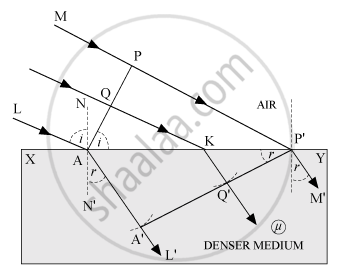Advertisements
Advertisements
Question
Using this principle draw a diagram to show how a plane wave front incident at the interface of the two media gets refracted when it propagates from a rarer to a denser medium. Hence verify Snell's law of refraction.
Solution
Huygens’ Principle:
• Each point on the primary wave front acts as a source of secondary wavelets, sending out disturbance in all directions in a similar manner as the original source of light does.
• The new position of the wave front at any instant (called secondary wave front) is the envelope of the secondary wavelets at that instant.
Refraction On The Basis Of Wave Theory

• Consider any point Q on the incident wave front.
• Suppose when disturbance from point P on incident wave front reaches point P'on the refracted wave front, the disturbance from point Q reaches Q' on the refracting surface XY.
• Since P'A'epresents the refracted wave front, the time taken by light to travel from a point on incident wave front to the corresponding point on refracted wave front should always be the same. Now, time taken by light to go from Q to Q' will be `t = (QK)/c + (KQ)/v ...(1)`
In right-angled ΔAQK, ∠QAK = i
∴ QK = AK sin i … (2)
In right-angled ΔP'Q'K, ∠Q'P'K, = r and KQ = KP sin r…. (3)
Substituting (2) and (3) in equation (1),
`t = (AK sin i)/c + (KP'sin r)/v`
or, `(AK sin i)/c + ((AP' - AK)sin r)/v` (∵ KP' = AP' -AK)
or,`t = (AP')/c sinr + AK ((sin i )/c - (sin r)/v) ...... (4)`
The rays from different points on the incident wave front will take the same time to reach the corresponding points on the refracted wave front i.e., t given by equation (iv) is independent of AK. It will happen so, if`(sin i)/c -(sin r)/v =0 ⇒ (sini)/(sinr) =c/v ⇒μ = (sini)/(sinr) `
This is the Snell’s law for refraction of light.
APPEARS IN
RELATED QUESTIONS
On the basis of Huygens' wave theory of light prove that velocity of light in a rarer medium is greater than velocity of light in a denser medium.
What is the shape of the wavefront in the following case?
Light diverging from a point source.
When the width of the slit is made double the original width, how would this affect the size and intensity of the central diffraction band?
With what type of source of light are cylindrical wave fronts associated?
According to Huygens principle, ______.
Relation between ray and wavefront is ______.
What is the phase difference between any two points lying on the same?
The inverse square law of intensity is valid for a
Two light beams of intensities in the ratio of 9 : 4 are allowed to interfere. The ratio of the intensity of maxima and minima ______.
What type of wavefronts are associated with a point source of light?
